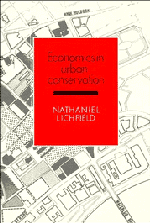Book contents
- Frontmatter
- Contents
- List of diagrams, tables and plans
- Preface
- Acknowledgements
- Introduction
- Part I Planning and management in the conservation of the urban system
- Part II Conservation of the cultural built heritage
- Part III Economics in urban conservation
- 7 Economics in the management of the built environment
- 8 Economics in the conservation of the CBH
- 9 Economics in planning for conservation of the CBH
- 10 Valuation of the cultural built heritage
- 11 Screening of the inventory or list
- 12 Who benefits and who loses from conservation of the CBH?
- Part IV Selected tools of economic analysis for project evaluation
- Part V Case studies in the economics of conservation of the CBH
- Notes
- Bibliography
- Index
8 - Economics in the conservation of the CBH
Published online by Cambridge University Press: 10 November 2010
- Frontmatter
- Contents
- List of diagrams, tables and plans
- Preface
- Acknowledgements
- Introduction
- Part I Planning and management in the conservation of the urban system
- Part II Conservation of the cultural built heritage
- Part III Economics in urban conservation
- 7 Economics in the management of the built environment
- 8 Economics in the conservation of the CBH
- 9 Economics in planning for conservation of the CBH
- 10 Valuation of the cultural built heritage
- 11 Screening of the inventory or list
- 12 Who benefits and who loses from conservation of the CBH?
- Part IV Selected tools of economic analysis for project evaluation
- Part V Case studies in the economics of conservation of the CBH
- Notes
- Bibliography
- Index
Summary
The CBH as a resource
Certain buildings are created with the intention of their being monuments (royal palaces, royal burial chambers, mansions intended to be the home of a family for generations, churches or mosques). These apart, when the CBH is initially developed it would not be seen as distinct from the generality of the built environment; it is by definition only later that the social decision is taken to conserve it.
Such a decision certainly constrains the use of the stock in question as a resource. For example, how can you expand the economic base of the community in manufacturing, retailing, commerce, etc. if large parts of the relevant fabric were designed with an eye to the requirements of centuries ago and conserved since? But in other respects the CBH can be seen as a resource of even higher value than if it were not so earmarked, as the following examples show:
Stock designed in a previous age can provide an environment which will not or cannot be reproduced today, and therefore offers a relatively scarce opportunity for both stability in the physical environment and enrichment of human experience.
Architecture from earlier centuries can give an aesthetic character to a locality which is distinctive from that provided solely by recent and contemporary generations, and can so enrich the human experience.
[…]
- Type
- Chapter
- Information
- Economics in Urban Conservation , pp. 145 - 151Publisher: Cambridge University PressPrint publication year: 1989



